Gas pressure: technical standards + distribution features on the line for gas pressure
The proximity of the gas pipeline network to the village does not guarantee no problems with connecting to it. The pipelines transporting the most popular fuel have different tasks, which is why the pressure in the gas pipeline is also different.
We will tell you how the gas transmission network works and what pressure the fuel supplied to the consumer in its linear segments is under. The article we presented sets out in detail the principles of organizing gas supply systems at various levels. Gas shutdown mechanisms are provided.
The content of the article:
Natural gas supply
Household and industrial equipment operating on a natural mixture of gaseous hydrocarbons is well known to everyone. In residential buildings, boilers, gas stoves and water heaters are installed.
Many enterprises have at their disposal boiler equipment and fenced "houses" of the GRU. And on the streets there are gas distribution points that attract attention with a yellow color and a bright red inscription “Gas. Flammable. ”
Everyone knows - gas flows through pipes. Just how does he get into these very pipes? The path traveled by natural gas to each apartment, each house is truly huge. Indeed, from the field to the final consumers, fuel flows through branched, sealed channels stretching for thousands of kilometers.
Immediately after production at the field, the gas mixture is purified from impurities and is prepared for pumping. Pumped by compressor stations to high pressure values, natural gas is routed through a main pipeline to a gas distribution station.
Its settings reduce the pressure and odorize the gas mixture with methane, ethane and pentane thiols, ethyl mercaptan and similar substances to give it a smell (in its pure form, natural gas has no smell).After additional purification, gaseous fuel is sent to the gas pipelines of settlements.
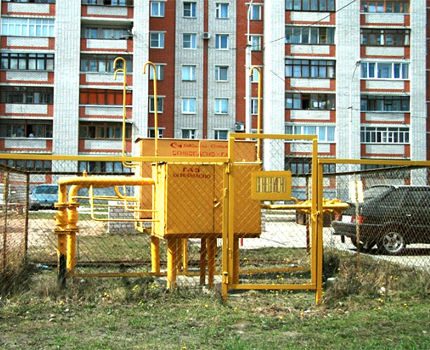
Natural gas then flows to the gas distribution points inside the city blocks. Before being sent to the gas pipeline network of the quarter, the pressure of the transported gas is reduced to the required minimum. Finally, the gas flows into the internal gas supply network - to the gas stove, water heater or floor boiler.
Each gas processing unit is equipped with a special burner that mixes the main fuel with air before burning. In its pure form (i.e., without oxygen access), the flammability of natural gas is zero.
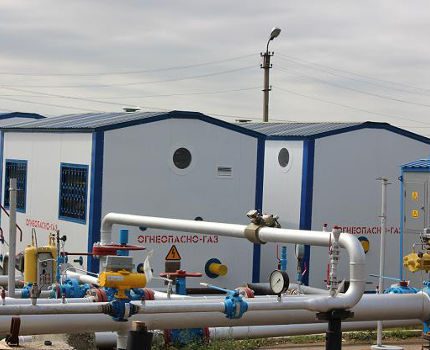
The composition of the gas supply system
The gas transportation complex is formed by pipelines and structures, as well as technical devices that supply and distribute the flow between consumers. The gas supply intensity is determined by the needs of end users - industrial and municipal organizations, private households.
The gas supply network consists of:
- pipelines of high, medium and low pressure;
- gas control devices - stations (GDS), points (hydraulic fracturing), installations (GRU);
- automatic control and monitoring systems;
- dispatching and operational services.
Under high pressure, the main gas pipeline delivers natural gas to the distribution stations, which lower the pressure level to that required by the valves of the automatic regulators.
Further gas networks direct fuel to consumers. GDS automatically maintains pressure indicators in a given range.
How is the gas supply system organized?
Its hierarchy is determined by the classes of gas transmission network elements associated with the pressure of the pumped natural gas.
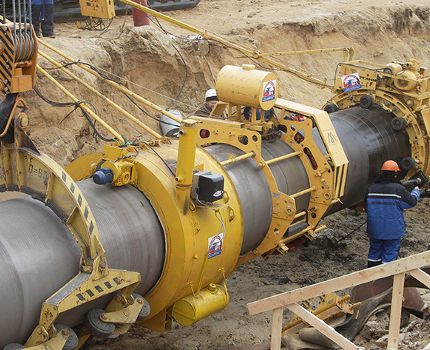
The principles of the gas network
The first level gas pipelines include gas pipelines in which the pressure of natural gas is high or medium. To avoid dead ends, gas pipelines are backed up - duplication of individual segments or banding. Creating a dead-end network is allowed only in small towns.
Natural gas under high pressure goes through several successive stages, where its pressure decreases. The process of pressure reduction in gas control points occurs in jumps, at the outlet of them the pressure is constant. In the urban area, gas communications with medium and high pressure form a hydraulically connected common network.
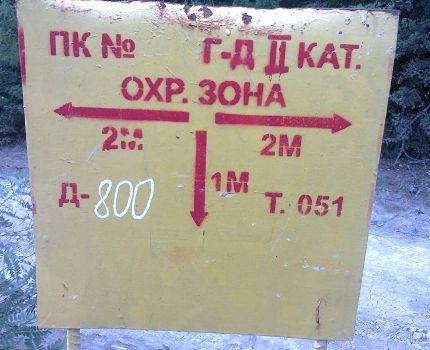
The use of hydraulic fracturing allows consumers to be supplied with gas of various pressures, even if they are located on the same street - gas pipelines of unequal pressures are placed in parallel.
Second-level gas pipelines provide low pressure gas fuel for the majority of consumers. Such networks are mixed, with a predominance of dead-end segments.Only main pipelines are ringed.
A low-pressure gas pipeline should not cross large industrial (motorways, railways) or natural (lakes, rivers, ravines) barriers. Installation of such communications in industrial areas is not allowed.

Gas networks supplying fuel under low pressure cannot form a hydraulically connected system of a large settlement. They are designed exclusively as local complexes fed by several hydraulic fracturing.
In turn, connected to medium pressure networks, which in turn are connected by analogy to high-pressure lines. The third level of network gas pipelines is used at consuming facilities - in the territories of enterprises, in residential and public buildings.
The need for pressure for such networks is determined by their purpose and the performance of gas-using devices (installations). Reservation (partial duplication) on gas communications of the third level is usually not made.
Types and categories of gas pipelines
The division of gas supply pipelines by type is reflected in SNiP 42-01-2002. High-pressure gas pipelines correspond to one type, subdivided into two categories.
Gas-conducting communications of the first category are located exclusively for consumers in the industrial sector, which consume significant volumes of gaseous fuel under a consistently high (0.6-1.2 MPa) pressure.
For example, it is steel mills. Connecting each industrial consumer to the gas pipeline of the first category requires the preparation of a special gas supply project.
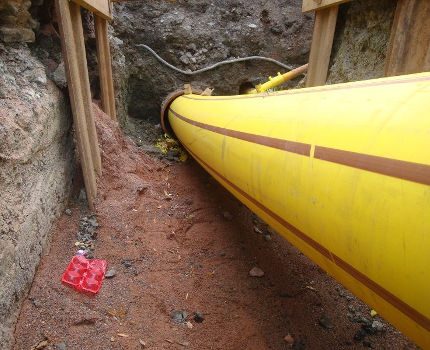
Conducting natural gas lines of the second category are created for other production facilities that need to supply the gas mixture under high pressure, but less (0.3-0.6 MPa) than consumers of the first category. The same gas pipelines supply fuel to boiler houses heating industrial buildings.
Pipelines supplying gas with an average pressure level (0.005-0.3 MPa) are led to boiler houses that heat household and administrative facilities. They are also used to provide public buildings in need of an increased amount of fuel.
Gas pipelines of low pressure level (up to 0.005 MPa) stretch to household consumers. All household equipment is designed specifically for such characteristics of gas supply.
Otherwise, by reducing the pressure parameters as much as possible, it is impossible to achieve maximum safety in gas communications for residential facilities. Organization of gas supply for residential buildings high-pressure lines and above are strictly prohibited.
Multistage gas supply system
The need to create several stages in the local natural gas supply system, incl. caused by the presence of consumers in need of gaseous fuel supplies under various pressures.
Graduation of gas pipelines by steps
The following gas supply systems are distinguished by the number of pressure steps:
- Two-stage. Formed by networks under pressure low and medium, or low and high;
- Three stage. Consist of communications with high, medium and low pressures;
- Step-step. They are formed by gas pipelines with pressures of all levels.
The alternation of high and medium pressure highways is required due to the considerable length of the network pipelines, as well as due to several directions of transportation.In areas with significant population density gas pipelinesconducting gaseous fuels under high pressure is not recommended.
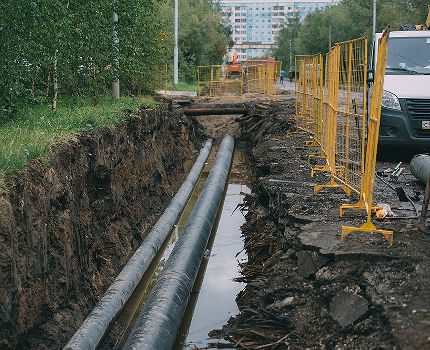
Another common reason is that in the old building areas, city streets are not wide enough to stretch high pressure gas lines under them. After all, the higher the pressure of the gas moving through the pipeline, the more significant the distance is needed between communications and neighboring buildings.
The need for a step-by-step scheme of gas supply is also caused by technological requirements for the connection and installation of gas control units installed on buildings.
Types of city networks according to purpose
Territories of urban areas are equipped with the most extensive network of gas supply communications.
The urban complex supplying natural gas includes the following types of pipelines:
- distribution, conductive gas under various (actually necessary) pressure. Provide transportation on the served territory;
- subscriber branches supplying gas from distribution lines to specific subscribers;
- intra-house and intra-workshop.
The gas distribution network designed for the city, directing gas under medium and high pressure, forms a common network. With specifics of development project for gasification of a private house Introduces our proposed article.
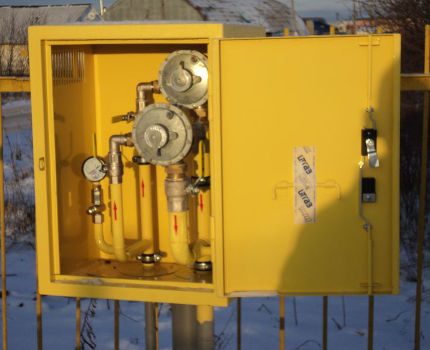
Those. Natural gas is supplied to communal consumers, boiler houses and industrial facilities through a common gas distribution network. The construction of separate backbone networks for household or industrial consumers is disadvantageous from the perspective of the economy.
When choosing planning solutions for urban gas supply, the planning and size of the city, population density and development, the needs of power plants and industrial facilities are taken into account. The prospects of the future development of the city, the presence of major obstacles (artificial, natural) for conducting gas pipelines are taken into account.
Features of urban gas supply planning
Within the city limits, an ideal natural gas supply scheme must be economically viable, operationally safe and reliable, convenient and uncomplicated in working with it.
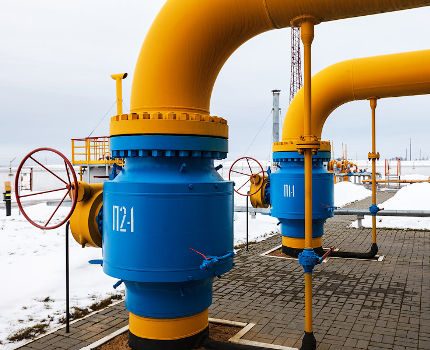
it is installed on the gas pipeline when it is discharged through the gas control station, allowing you to switch the gas supply circuits of the system
The gas supply pipeline network must allow accidental shutdown of its individual segments to carry out repairs. A prerequisite is the complete uniformity of nodes, equipment and structures within one system.
When depicted in the diagram, city gas pipelines are shown sequentially. However, laying parallel gas communications is allowed along the streets, subject to different pressures in them.
Such a layout is cost-effective, as it reduces the consumption of pipes:
- gas lines of low pressure are fed by several hydraulic fracturing;
- methane is supplied to the central hydraulic fracturing in parallel with medium or high pressure gas pipelines.
Similar schemes for laying communications are used to supply boiler houses and enterprises located inside residential areas.
The urban development structure requires the construction of a low pressure network in the format of two unconnected zones.For redundancy at a low pressure level, hydraulic fracturing of each of the two zones is connected to large-diameter pipelines that conduct gas at low pressure.
In cities of small and medium size, a two-stage complex of gas pipelines is used that combines low and high pressure communications (not more than 0.6 MPa).
If it is impossible to lay gas pipes in the city center for pumping a high-pressure gas mixture, their design capacities are divided between high-pressure networks (laid in the periphery) and medium pressure (created in the central part).
The result is a three-stage natural gas supply system, equipped with distribution pipelines with a diameter of 50-400 mm.
Before the construction of a separate gas transmission line and before tapping into an existing gas pipe design of the planned section of the system is in progress hydraulic calculationproviding an opportunity to pick up gas pipes and fittings for arranging the network.
Natural gas shutdown mechanisms
Performing repairs requires periodic shutdown of certain sections of the city gas pipelines, consisting of high and medium pressure, as well as certain networks under low pressure.
Therefore, gas piping systems of network, public and residential pipelines, as well as industrial facilities or several buildings are equipped with shut-off devices - gate valves (another name - plug valves).
The assembly of the communication system is completed according to the rules. gas line pressure testing, allowing to identify problem areas. They most often occur at the locations of the locking devices.
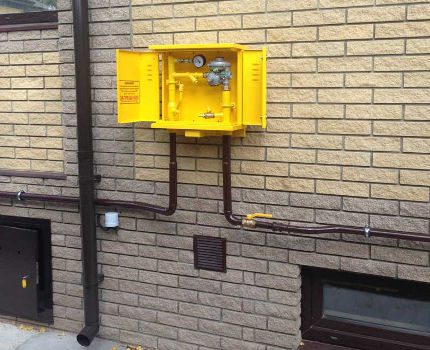
Installation of valves is carried out:
- on gas pipes in hydraulic fracturing (outgoing and incoming);
- on branches of the main gas pipelines going to microdistricts and quarters;
- in front of a large barrier crossed by a pipeline (water bodies, automobile and railway tracks).
On the external gas pipelines, the valves are installed with deepening in the wells. Together with them are mounted lens compensators designed to take voltage readings (mounting, temperature) through the pipeline, as well as to facilitate the procedures for setting and removing shutoff valves.
It is permissible to lay the wells at a distance of more than 2 m from the nearest building or fence.
Shut-off valves on gas inlets in buildings are placed on the wall. Gas taps, with the introduction of which they will introduce next article, placed with maintaining a meter distance from the nearest openings.
Regardless of the level of pressure, branching, and the length of the pipeline conducting the gas mixture, the number of shutdown devices should be minimally necessary, with justification for each location.
An important issue for owners is the price of connecting to the main gas, the details of which are defined given here. We recommend that you familiarize yourself with useful material.
Conclusions and useful video on the topic
Video # 1. How is the gas supply of the apartment building:
Video # 2. How it is arranged and how ball valves for gas pipelines are made:
The gas pipeline system ensures a sound supply of natural gas only if it is balanced. Any work with gas transmission equipment may be carried out exclusively by gas service employees. Extraneous interventions in the operation of the gas network are unacceptable and extremely dangerous - remember this!
Please write comments in the block below. Share valuable recommendations and information that will be useful to site visitors. Leave posts, post photos on the topic, ask questions.

 Natural gas odorant: features of odorants, norms and rules for their entry
Natural gas odorant: features of odorants, norms and rules for their entry 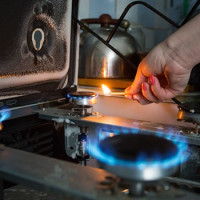 Types of domestic gas: what gas comes to our apartments + features of domestic gas
Types of domestic gas: what gas comes to our apartments + features of domestic gas 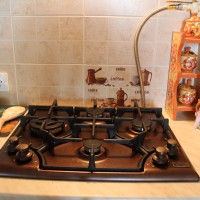 Distance from gas equipment to electrical wiring: technical regulations
Distance from gas equipment to electrical wiring: technical regulations 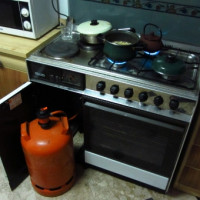 Is it possible to keep a gas cylinder in an apartment: rules and regulations for the use of balloon gas
Is it possible to keep a gas cylinder in an apartment: rules and regulations for the use of balloon gas 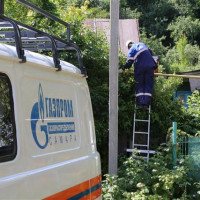 Where to call if there is no gas in the apartment: reasons for disconnection + procedure for the absence of gas
Where to call if there is no gas in the apartment: reasons for disconnection + procedure for the absence of gas 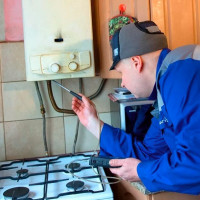 Rules for the operation of gas equipment in residential buildings: measures and standards for safe use
Rules for the operation of gas equipment in residential buildings: measures and standards for safe use  How much does it cost to connect gas to a private house: the price of organizing gas supply
How much does it cost to connect gas to a private house: the price of organizing gas supply  The best washing machines with dryer: model rating and customer tips
The best washing machines with dryer: model rating and customer tips  What is the color temperature of light and the nuances of choosing the temperature of the lamps to suit your needs
What is the color temperature of light and the nuances of choosing the temperature of the lamps to suit your needs  Replacement of a geyser in an apartment: replacement paperwork + basic norms and requirements
Replacement of a geyser in an apartment: replacement paperwork + basic norms and requirements
My daughter is a 3rd year college student majoring in “Installation and operation of gas supply equipment and systems”. She recently wrote her first term paper, and I saw how she drew in a computer in a program for automatic design. I am once again convinced that this is a complex and responsible profession. Almost only boys study in their group, but they relate to study with a chill. In the hands of these still students, our safety, a lot will depend on their knowledge.
Yla, did not see the output in your comment. And in general, how does this relate to the material here? Now wherever you look, a serious approach is needed everywhere. Maybe your daughter is also not serious, how do you know how much she drew there. And the guys are still young, everything has its time. Knowing our educational system and the attitude of educational institutions towards employment, most of them will not work in their specialty, the group and the group are different.
Explain to me “dense”, I can’t understand this question for many years using the Internet ... everything seems to be clear: 1 bar = 1 atmosphere, well, so rude, = 0.1 Mpascal. High pressure network 0.6-1.2mp = 6-12 bar, medium 0.3-0.6mp = 3-6 bar, low pressure 0.005-0.3 = attention 0.05 bar = 0.05 atmospheres, i.e. what happens, how will the gas come out if its pressure is 20 times lower than atmospheric ????
In the calculations, overpressure is used. Read about absolute and overpressure. There are a lot of online gas pipeline calculations on the Internet, visit any form of support there. I won’t write links, otherwise they won’t miss a comment. In Yandex ->
Sergei! You forgot that natural gas is not a liquid. Natural gas is compressed under pressure and the higher the gas pressure in the pipelines, the more concentrated and energy-intensive, that is, its quality and calorific value are better. Therefore, for suckers, the pressure in the low-pressure pipelines is artificially reduced so that consumers receive less fuel and pay as for high-quality gas! Professional banditry on behalf of “NATIONAL DOMAIN”.